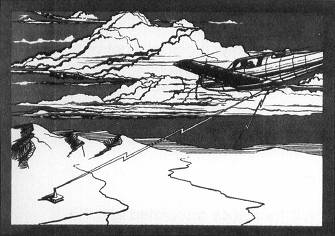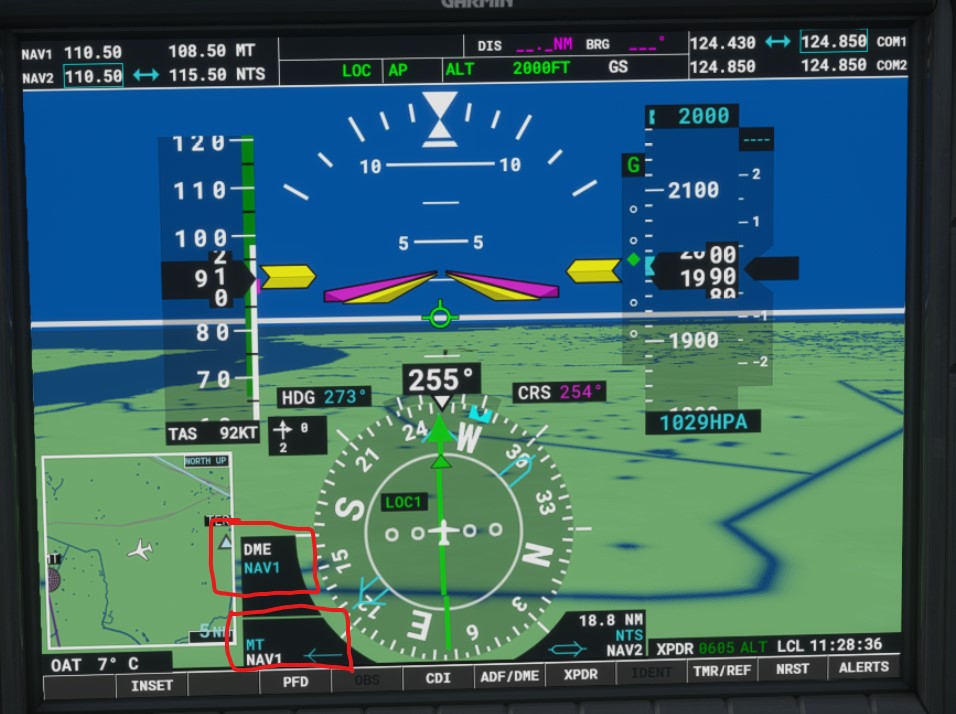
NDBs, localizers, and off-route VORs are used to establish intersections. If the triangle is solid, a report is compulsory. An open triangle indicates the location of an ATC reporting point at an intersection. Intersections along the airway route are established by a variety of NAVAIDs.  When a change of MEA to a higher MEA is required, the climb may commence at the break, ensuring obstacle clearance. If there is an airway break without the symbol, one can assume the altitudes have not changed (see the upper left area of Figure 1-2). Chart depictions appear as "MAA-15000." When an MEA, MOCA, and/or MAA change on a segment other than at a NAVAID, a sideways "T" () is depicted on the chart. The maximum authorized altitude (MAA) is the highest altitude at which the airway can be flown with assurance of receiving adequate navigation signals. On AeroNav Products charts, the MCA is indicated by the symbol, and the Victor airway number, altitude, and the direction to which it applies (e.g. In this case, the pilot is required to initiate a climb so the MCA is reached by the time the intersection is crossed. The MCA is usually indicated when a pilot is approaching steeply rising terrain and obstacle clearance and/or signal reception is compromised. The minimum crossing altitude (MCA) is charted when a higher MEA route segment is approached. On AeroNav Products charts, the MRA is indicated by the symbol and the altitude preceded by "MRA" (e.g., "MRA 9300"). However, if the aircraft is equipped with distance measuring equipment (DME) and the chart indicates the intersection can be identified with such equipment, the pilot could define the fix without attaining the MRA. If the reception is line-of-sight based, signal coverage only extends to the MRA or above. The minimum reception altitude (MRA) identifies the lowest altitude at which an intersection can be determined from an off-course NAVAID. The MOCA is listed below the MEA and indicated on AeroNav Products charts by a leading asterisk (e.g., "*3400" - see Figure 1-2, V287 at bottom left). The minimum obstruction clearance altitude (MOCA), as the name suggests, provides the same obstruction clearance as an MEA however, the NAV signal reception is ensured only within 22 NM of the closest NAVAID defining the route. Arrows are used to indicate the direction to which the MEA applies. MEAs are usually bidirectional however, they can be single-directional. MEAs can be authorized with breaks in the signal coverage if this is the case, the AeroNav Products en route chart notes "MEA GAP" parallel to the affected airway. The obstacle clearance, within the limits of the airway, is typically 1,000' in non-mountainous areas and 2,000' in designated mountainous areas. Communication is not necessarily guaranteed with MEA compliance. The minimum en route altitude (MEA) ensures a navigation signal strong enough for adequate reception by the aircraft navigation (NAV) receiver and obstacle clearance along the airway. When the AeroNav Products en route chart is unfolded, the legend is displayed and provides information concerning airports, NAVAIDs, communications, air traffic services, and airspace. The en route charts are revised every 56 days. Information concerning MTRs is also included on the chart cover. The effective date of the chart is printed on the other side of the folded chart. Also noted is an explanation of the off-route obstruction clearance altitude (OROCA).
When a change of MEA to a higher MEA is required, the climb may commence at the break, ensuring obstacle clearance. If there is an airway break without the symbol, one can assume the altitudes have not changed (see the upper left area of Figure 1-2). Chart depictions appear as "MAA-15000." When an MEA, MOCA, and/or MAA change on a segment other than at a NAVAID, a sideways "T" () is depicted on the chart. The maximum authorized altitude (MAA) is the highest altitude at which the airway can be flown with assurance of receiving adequate navigation signals. On AeroNav Products charts, the MCA is indicated by the symbol, and the Victor airway number, altitude, and the direction to which it applies (e.g. In this case, the pilot is required to initiate a climb so the MCA is reached by the time the intersection is crossed. The MCA is usually indicated when a pilot is approaching steeply rising terrain and obstacle clearance and/or signal reception is compromised. The minimum crossing altitude (MCA) is charted when a higher MEA route segment is approached. On AeroNav Products charts, the MRA is indicated by the symbol and the altitude preceded by "MRA" (e.g., "MRA 9300"). However, if the aircraft is equipped with distance measuring equipment (DME) and the chart indicates the intersection can be identified with such equipment, the pilot could define the fix without attaining the MRA. If the reception is line-of-sight based, signal coverage only extends to the MRA or above. The minimum reception altitude (MRA) identifies the lowest altitude at which an intersection can be determined from an off-course NAVAID. The MOCA is listed below the MEA and indicated on AeroNav Products charts by a leading asterisk (e.g., "*3400" - see Figure 1-2, V287 at bottom left). The minimum obstruction clearance altitude (MOCA), as the name suggests, provides the same obstruction clearance as an MEA however, the NAV signal reception is ensured only within 22 NM of the closest NAVAID defining the route. Arrows are used to indicate the direction to which the MEA applies. MEAs are usually bidirectional however, they can be single-directional. MEAs can be authorized with breaks in the signal coverage if this is the case, the AeroNav Products en route chart notes "MEA GAP" parallel to the affected airway. The obstacle clearance, within the limits of the airway, is typically 1,000' in non-mountainous areas and 2,000' in designated mountainous areas. Communication is not necessarily guaranteed with MEA compliance. The minimum en route altitude (MEA) ensures a navigation signal strong enough for adequate reception by the aircraft navigation (NAV) receiver and obstacle clearance along the airway. When the AeroNav Products en route chart is unfolded, the legend is displayed and provides information concerning airports, NAVAIDs, communications, air traffic services, and airspace. The en route charts are revised every 56 days. Information concerning MTRs is also included on the chart cover. The effective date of the chart is printed on the other side of the folded chart. Also noted is an explanation of the off-route obstruction clearance altitude (OROCA). 
Cities near congested airspace are shown in black type and their associated area chart is listed in the box in the lower left-hand corner of the map coverage box.When folded, the cover of the AeroNav Products en route chart displays an index map of the United States showing the coverage areas.The IFR low altitude en route chart is the instrument equivalent of the sectional chart.To effectively depart from one airport and navigate en route under instrument conditions, a pilot needs the appropriate IFR en route low-altitude chart(s).

Established jet routes from 18,000' MSL to FL 450 use NAVAIDs not more than 260 NM apart.Information includes the portrayal of Jet and RNAV routes, identification and frequencies of radio aids, selected airports, distances, time zones, special use airspace, and related information.En route high-altitude charts provide aeronautical information for en route instrument navigation at or above 18,000' MSL.AeroNav Products maintains and produces the charts for the U.S.Your ability to fly instruments safely and competently in the system is greatly enhanced by understanding the vast array of data available to the pilot on instrument charts.The objective of IFR en route flight is to navigate within the lateral limits of a designated airway at an altitude consistent with the ATC clearance.







 0 kommentar(er)
0 kommentar(er)
